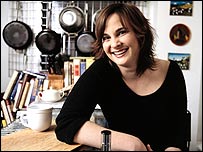I've been trying different techniques for grilling/smoking pork ribs and finally hit on something I really liked.
Since first making my Hickory Maple sauce, I haven't tried anything as good. I do have some recipes not yet tried, but the family and I like this one so much we have no incentive to change. But sauce does not make the dish alone. It's really just the finishing touch.
For some time I've used one method or another of cooking the ribs before they hit the grill, including boiling and baking. There are two advantages to pre-cooking. I think you can get a better result in the end, and it saves time, because you're cooking them while the coals are heating. Yesterday, I steamed them, and that got me the perfect result I've been seeking.
I filled the bottom of a big pot with water, dropped in a vegetable steamer, covered it and set the flame to high. I went outside and lit the charcoal. Back inside, I covered the ribs liberally with a dry rub. It was the last of a rub I had been using for some months, and I'm embarrassed to say I don't know where I got the recipe -- I'll hunt through my cookbooks for it, because it was pretty good.
By then the water was boiling. I was using a full rack of spare ribs which I had cut in half. They fit in the pot with one somewhat on top of the other. The steam cooked off lots of excess fat, and made the dry rub into a paste that stuck to the ribs.
When the coals were ready -- in about 30 minutes -- I removed the ribs from the pot and let them drip off. I spread the coals for direct grilling. I skipped my usual step of adding soaked hickory chips to the coals, but as the sauce includes Liquid Smoke, I knew I'd get some hickory flavor.
I put the ribs on the grill, covered it and closed the top vents halfway to retain smoke. After 10 minutes, I turned the ribs and mopped on some white vinegar with hot pepper flakes. Returning the cover, I now opened the vents. In 10 more minutes, I turned the ribs and repeated. The ribs were nicely blackened but not overly charred. Five minutes later, I brushed on some sauce, turned the ribs and brushed sauce on the other side. Just a minute or two on each side with the cover off produced a nice glaze.
I put the ribs on a cutting board and returned to the kitchen. With a carving knife (and I plan to buy a cleaver), I trimmed the rack to produce St. Louis cut ribs. If you order spare ribs in a restaurant, chances are that's how you'll get them. You do this by removing the unwieldy section at the top of the rack that is difficult to slice through as well as the tip of the rack, so that you're left with ribs of a fairly consistent length.
I'm sure there is correct terminology for this, but what it left me with was a nearly uncuttable long bone that had run perpendicular to the ribs and a number of chunks that I separated into tasty morsels, along with the small ribs at the end of the rack.
Arranging all the pieces on a platter, I brushed some more sauce on top. They were the best ribs we've ever had. Moist inside and crispy on the top and bottom. The St. Louis portion of the rack was also fairly lean.
I would also say that meat quality makes a difference. I find the ribs purchased at Whole Foods significantly better in taste and texture than the ones I used to buy at Sam's Club. But they are perhaps twice as expensive. For now, we've decided we'd rather have naturally raised meat, and if it means having ribs a bit less often, so be it.
Sunday, August 19, 2007
Subscribe to:
Post Comments (Atom)




2 comments:
YuuuuuuuuuuuuuuuuK.That sounds horrid.Never,ever boil ribs
Steamed, not boiled.
Post a Comment